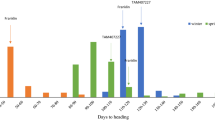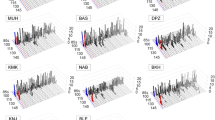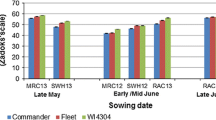Abstract
Heading date is a key trait for the adaptation of barley to Mediterranean environments. We studied the genetic control of flowering time under Northern Spanish (Mediterranean) conditions using a new population derived from the spring/winter cross Beka/Mogador. A set of 120 doubled haploid lines was evaluated in the field, and under controlled temperature and photoperiod conditions. Genotyping was carried out with 215 markers (RFLP, STS, RAPD, AFLP, SSR), including markers for vernalization candidate genes, HvBM5 (Vrn-H1), HvZCCT (Vrn-H2), and HvT SNP22 (Ppd-H1). Four major QTL, and the interactions between them, accounted for most of the variation in both field (71–92%) and greenhouse trials (55–86%). These were coincident with the location of the major genes for response to vernalization and short photoperiod (Ppd-H2 on chromosome 1H). A major QTL, near the centromere of chromosome 2H was the most important under autumn sowing conditions. Although it is detected under all conditions, its action seems not independent from environmental cues. An epistatic interaction involving the two vernalization genes was detected when the plants were grown without vernalization and under long photoperiod. The simultaneous presence of the winter Mogador allele at the two loci produced a marked delay in heading date, beyond a mere additive effect. This interaction, combined with the effect of the gene responsive to short photoperiod, Ppd-H2, was found responsible of the phenomenon known as short-day vernalization, present in some of the lines of the population.






Similar content being viewed by others

References
Benjamini Y, Hochberg Y (1995) Controlling the false discovery rate: a practical and powerful approach to multiple testing. J R Stat Soc 57:289–300
Blake TK, Kadyrzhanova D, Sheperd KW et al (1996) STS-PCR markers appropriate for wheat-barley introgression. Theor Appl Genet 93:286–832
Börner A, Buck-Sorlin GH, Hayes PM, Malyshev S, Korzun V (2002) Molecular mapping of major genes and quantitative trait loci determining flowering time in response to photoperiod in barley. Plant Breed 121:129–132
Boyd WJR, Li CD, Grime CR, Cakir M, Potipibool S, Kaveeta L, Men S, Kamali MRJ, Barr AR, Moody DB, Lance RCM, Logue SJ, Raman H, Rea BJ (2003) Conventional and molecular genetic analysis of factors contributing to variation in the timing of heading among spring barley (Hordeum vulgare L) genotypes grown over a mild winter growing season. Aust J Agric Res 54: 1277–1301
Canci PC, Nduulu LM, Muehlbauer GJ, Dill-Macky R, Rasmusson DC, Smith KP. 2004. Validation of quantitative trait loci for Fusarium head blight and kernel discoloration in barley. Mol Breed 14:91–104
Casas AM, Igartua E, Vallés MP, Molina-Cano JL (1998) Genetic diversity of barley cultivars grown in Spain estimated by RFLP similarity and coancestry coefficients. Plant Breed 117:429–435
Dahleen LS, Agrama HA, Horsley RD, Steffenson BJ, Schwarz PB, Mesfin A, Franckowiak JD (2004) Identification of QTLs associated with Fusarium head blight resistance in Zhedar 2 barley. Theor Appl Genet 108:95–104
Dávila JA, Loarce Y, Ferrer E (1999) Molecular characterization and genetic mapping of random amplified microsatellite polymorphism in barley. Theor Appl Genet 98:265–273
Faure S, Higgins J, Turner A, Laurie DA (2007) The FLOWERING LOCUS T-like gene family in barley (Hordeum vulgare). Genetics. doi:10.1534/genetics.106.069500
Francia E, Rizza F, Cattivelli L, Stanca AM, Galiba G, Tóth B, Hayes PM, Skinner JS, Pecchioni N (2004) Two loci on chromosome 5H determine low-temperature tolerance in a ‘Nure’ (winter) × ‘Tremois’ (spring) barley map. Theor Appl Genet 108:670–680
Franckowiak JD, Konishi T (2002) Early maturity 6, Eam6. Barley Genet Newsl 32:86–87
Fu D, Szűcs P, Yan L, Helguera M, Skinner JS, von Zitzewitz J, Hayes PM, Dubcovsky J (2005) Large deletions within the first intron in VRN-1 are associated with spring growth habit in barley and wheat. Mol Genet Genomics 273:54–65
Gallagher LW, Soliman KM, Vivar H (1991) Interactions among loci conferring photoperiod insensitivity for heading time in spring barley. Crop Sci 31:256–261
Gallagher LW, Franckowiak JD (1997) Early maturity 10. Barley Genet Newsl 26:166
Hayes PM, Liu BH, Knapp SJ, Chen F, Jones B, Blake T, Franckowiak J, Rasmusson D, Sorrells M, Ullrich SE, Wesenberg D, Kleinhofs A (1993) Quantitative trait locus effects and environmental interaction in a sample of North American barley germ plasm. Theor Appl Genet 87:392–401
Holland JB, Cervantes-Martinez CT, Nyquist W (2003) Estimating and interpreting heritability for plant breeding. Plant Breed Rev 22:9–112
Horsley RD, Schmierer D, Maier C, Kudrna D, Urrea CA, Steffenson BJ, Schwarz PB, Franckowiak JD, Green MJ, Zhang B, Kleinhofs A (2006) Identification of QTLs associated with Fusarium head blight resistance in barley accession CIho 4196. Crop Sci 46:145–156
Igartua E, Casas AM, Ciudad F, Montoya JL, Romagosa I (1999) RFLP markers associated with major genes controlling heading date evaluated in a barley germ plasm pool. Heredity 83:551–559
Kane NA, Danyluk J, Tardif G, Ouellet F, Laliberte JF, Limin AE, Fowler DB, Sarhan F (2005) TaVRT-2, a member of the StMADS-11 clade of flowering repressors, is regulated by vernalization and photoperiod in wheat. Plant Physiol 138:2354–2363
Kao CH, Zeng ZB, Teasdale RD (1999) Multiple interval mapping for quantitative trait loci. Genetics 152:1203–1216
Karsai I, Szűcs P, Mészáros K, Filichkina T, Hayes PM, Skinner JS, Láng L, Bedő Z (2005) The Vrn-H2 locus is a major determinant of flowering time in a facultative × winter growth habit barley (Hordeum vulgare L) mapping population. Theor Appl Genet 110:1458–1466
Kleinhofs A, Han F (2002) Molecular mapping of the barley genome. In: Slafer GA, Molina-Cano JL, Savin R, Araus JL, Romagosa I (eds) Barley science: recent advances from molecular biology to agronomy of yield and quality. Food Product Press, New York, pp 31–45
Kóti K, Karsai I, Szűcs P, Horváth Cs, Mészáros K, Kiss GB, Bedö Z, Hayes PM (2006) Validation of the two-gene epistatic model for vernalization response in a winter × spring barley cross. Euphytica 152:17–24
Künzel G, Korzun L, Meister A (2000) Cytologically integrated physical restriction fragment length polymorphism maps for the barley genome based on translocation breakpoints. Genetics 154:397–412
Laurie DA (1997) Comparative genetics of flowering time. Plant Mol Biol 35:167–177
Laurie DA, Pratchett N, Bezant JH, Snape JW (1994) Genetic analysis of a photoperiod response gene on the short arm of chromosome 2 (2H) of Hordeum vulgare (barley). Heredity 72:619–627
Laurie DA, Pratchett N, Bezant JH, Snape JW (1995) RFLP mapping of five major genes and eight quantitative trait loci controlling flowering time in a winter × spring barley (Hordeum vulgare L) cross. Genome 38:575–585
Liu ZW, Biyashev RM, Saghai Maroof MA (1996) Development of simple sequence repeat DNA markers and their integration into a barley linkage map. Theor Appl Genet 93:869–876
Ludlow MM, Muchow RC (1988) Critical evaluation of the possibilities for modifying crops for high production per unit of precipitation. In: Bidinger FR, Johansen C (eds) Drought research priorities for the dryland tropics. ICRISAT, Patancheru
Marquez-Cedillo LA, Hayes PM, Kleinhofs A, Legge WG, Rossnagel BG, Sato K, Ullrich SE, Wesenberg DM (2001) QTL analysis of agronomic traits in barley based on the doubled haploid progeny of two elite North American varieties representing different germplasm groups. Theor Appl Genet 103:625–637
Mesfin A, Smith KP, Dill-Macky R, Evans CK, Waugh R, Gustus CD, Muehlbauer GJ (2003) Quantitative trait loci for Fusarium head blight resistance in barley detected in a two-rowed by six-rowed population. Crop Sci 43:307–318
Moralejo M, Swanston JS, Muñoz P, Prada D, Elia M, Russell JR, Ramsay L, Cistue L, Codesal P, Casas AM, Romagosa I, Powell W, Molina-Cano JL (2004) Use of new EST markers to elucidate the genetic differences in grain protein content between European and North American two-rowed malting barleys. Theor Appl Genet 110:116–125
Pan A, Hayes PM, Chen F, Chen THH, Blake T, Wright S, Karsai I, Bedö Z (1994) Genetic analysis of the components of winterhardiness in barley (Hordeum vulgare L). Theor Appl Genet 89:900–910
Pillen K, Binder A, Kreuzkam B, Ramsay L, Waugh R, Förster J, Léon J (2000) Mapping new EMBL-derived barley microsatellites and their use in differentiating German barley cultivars. Theor Appl Genet 101:652–660
Pillen K, Zacharias A, Léon J (2003) Advanced backcross QTL analysis in barley (Hordeum vulgare L). Theor Appl Genet 107:340–352
Pillen K, Zacharias A, Léon J (2004) Comparative AB-QTL analysis in barley using a single exotic donor of Hordeum vulgare ssp. spontaneum. Theor Appl Genet 108:1591–1601
Qi X, Lindhout P (1997) Development of AFLP markers in barley. Mol Gen Genet 254:330–336
Qi X, Niks RE, Stam P, Lindhout P (1998) Identification of QTLs for partial resistance to leaf rust (Puccinia hordei) in barley. Theor Appl Genet 96:1205–1215
Ramsay L, Macaulay M, degli Ivanissevich S, MacLean K, Cardle L, Fuller J, Edwards KJ, Tuvesson S, Morgante M, Massari A, Maestri E, Marmiroli N, Sjakste T, Ganal M, Powell W, Waugh R (2000) A simple sequence repeat-based linkage map of barley. Genetics 156:1997–2005
Read BJ, Raman H, McMichael G, Chalmers KJ, Ablett GA, Platz GJ, Raman R, Genger RK, Boyd WJR, Li CD (2003) Mapping and QTL analysis of the barley population Sloop × Halcyon. Aust J Agric Res 54:1145–1153
Roberts EH, Summerfield RJ, Cooper JP, Ellis RH (1988) Environmental control of flowering in barley (Hordeum vulgare L). I Photoperiod limits to long-day responses, photoperiod-insensitive phases and effects of low temperature and short-day vernalization. Ann Bot 62:127–144
See D, Kanazin V, Kephart K, Blake T (2002) Mapping genes controlling variation in barley grain protein concentration. Crop Sci 42:680–685
Slafer GA, Whitechurch EM (2001) Manipulating wheat development to improve adaptation and to search for alternative opportunities to increase yield potential. In: Reynolds MP, Ortiz-Monasterio JI, McNab A (eds) Application of physiology in wheat breeding. CIMMYT, México DF, pp 160–170
Szűcs P, Karsai I, von Zitzewitz J, Mészáros K, Cooper L, Gu Y, Chen T, Hayes PM, Skinner J (2006) Positional relationships between photoperiod response QTL and photoreceptor and vernalization genes in barley. Theor Appl Genet 112:1277–1285
Szűcs P, Skinner JS, Karsai I, Cuesta-Marcos A, Haggard KG, Corey AE, Chen THH, Hayes PM (2007). Validation of the VRN-H2/VRN-H1 epistatic model in barley reveals that intron length variation in VRN-H1 may account for a continuum of vernalization sensitivity. Mol Genet Genomics 277:249–261
Takahashi R, Yasuda S (1971) Genetics of earliness and growth habit in barley. In: Nilan RA (ed) Barley genetics II. Proc 2nd Int Barley Genet Symp, Washington State University Press, Pullman, pp 388–408
Talamè V, Sanguineti MC, Chiapparino E, Bahri H, Salem BM, Forster BP, Ellis RP, Rhouma S, Zoumarou W, Waugh R, Tuberosa R (2004) Identification of Hordeum spontaneum QTL alleles improving field performance of barley grown under rainfed conditions. Ann Appl Biol 144:309–319
Tinker NA, Mather DE (1995) MQTL: software for simplified composite interval mapping of QTL in multiple environments. J Agric Genomics, http://wheat.pw.usda.gov/jag/papers95/paper295/index295.html. Published with permission from CAB international
Tohno-oka T, Ishit M, Kanatani R, Takahashi H, Takeda K (2000) Genetic analysis of photoperiod response of barley in different daylength conditions. In: Logue S (ed) Barley genetics VIII, Proc 8th Int Barley Genet Symp Volume VIII, Adelaide Dept Plant Science, Waite Campus, Adelaide University, Glen Osmond, South Australia, pp 239–241
Trevaskis B, Hemming MN, Peacock WJ, Dennis ES (2006) HvVRN2 Responds to daylength, whereas HvVRN1 is regulated by vernalization and developmental status. Plant Physiol 140:1397–1405
Trione EJ, Metzger RJ (1970) Wheat and barley vernalization in a precise temperature gradient. Crop Sci 10:390–392
Turner A, Beales J, Faure S, Dunford RP, Laurie DA (2005) The pseudo-response regulator Ppd-H1 provides adaptation to photoperiod in barley. Science 310:1031–1034
van Ooijen JW, Voorrips RE (2001) JoinMap® 3.0, software for the calculation of genetic linkage maps. Plant Research International, Wageningen
von Zitzewitz J, Szűcs P, Dubcovsky J, Yan L, Pecchioni N, Francia E, Casas A, Chen THH, Hayes PM, Skinner JS (2005) Molecular and structural characterization of barley vernalization genes. Plant Mol Biol 59:449–467
Wang S, Basten CJ, Zeng ZB (2007) Windows QTL Cartographer 2.5. Department of Statistics, North Carolina State University, Raleigh. NC. http://www.statgen.ncsu.edu/qtlcart/WQTLCart.htm
Waugh R, Bonar N, Baird E, Graner TA, Hayes PM, Powell W (1997) Homology of AFLP products in three mapping populations of barley. Mol Gen Genet 255:311–321
Yan L, Loukoianov A, Tranquilli G, Helguera M, Fahima T, Dubcovsky J (2003) Positional cloning of the wheat vernalization gene VRN1. Proc Natl Acad Sci USA 100:6263–6268
Yan L, Loukoianov A, Blechl A, Tranquilli G, Ramakrishna W, SanMiguel P, Bennetzen JL, Echenique V, Dubcovsky J (2004) The wheat VRN2 gene is a flowering repressor down-regulated by vernalization. Science 303:1640–1644
Zeng ZB (1994) Precision mapping of quantitative trait loci. Genetics 136:1457–1468
Acknowledgements
This work was supported by the Spanish Ministry of Education and Research (Projects AGF98-0251-C03, AGL2001-2289, including a scholarship granted to Alfonso Cuesta-Marcos, and AGL2004-05311) and by the European Regional Development Fund.
Author information
Authors and Affiliations
Corresponding author
Electronic supplementary material
Rights and permissions
About this article
Cite this article
Cuesta-Marcos, A., Igartua, E., Ciudad, F.J. et al. Heading date QTL in a spring × winter barley cross evaluated in Mediterranean environments. Mol Breeding 21, 455–471 (2008). https://doi.org/10.1007/s11032-007-9145-3
Received:
Accepted:
Published:
Issue Date:
DOI: https://doi.org/10.1007/s11032-007-9145-3



